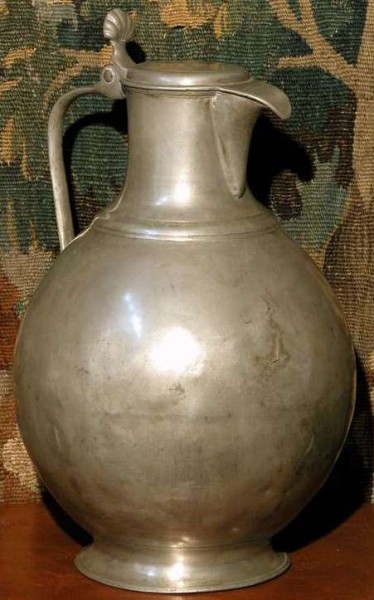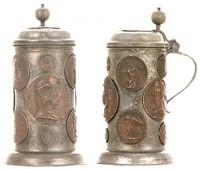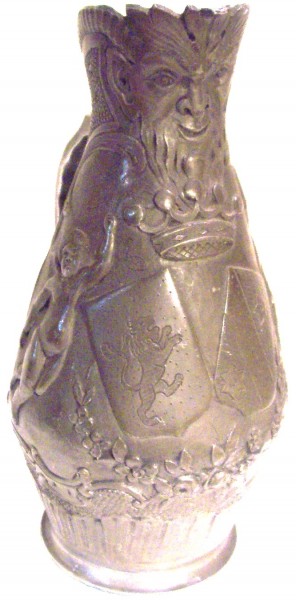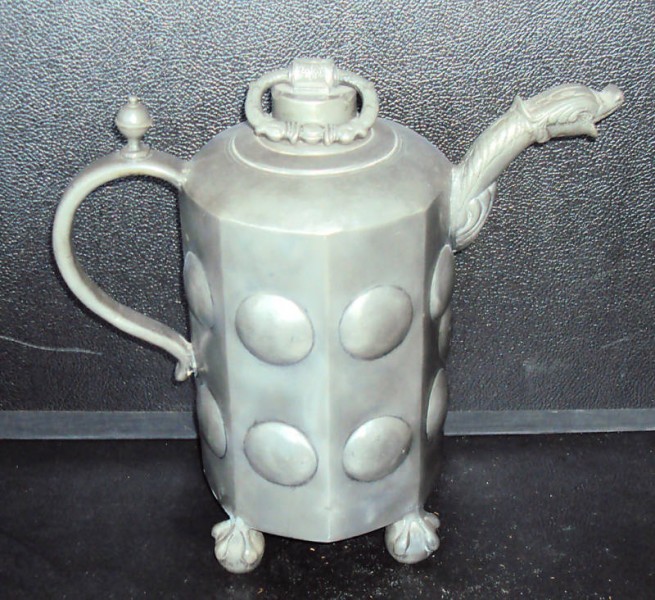“You Are Only as Good as Your Books.”

Netherlands Pewter 2 liter Flagon – Circa 1780.
ORIGINALLY PUBLISHED IN “THE JOURNAL OF ANTIQUES AND COLLECTIBLES” DECEMBER 2003,
“In the 1970s Manny Goldman and I wrote antique- and art-related articles for the Central Maine Morning Sentinel. The pay was notoriously low considering that many of my articles filled two pages. Despite the long hours and the low pay, I, as a young writer, wanted more. Manny Goldman was the person who stood in my way.”
“Manny’s articles were informative and fun to read, but to be frank, I thought my articles were more hard-hitting and challenged the reader to take action. The fact that some readers wrote or called the editor to object to something I had written did not bother me at all. And then, it happened. Manny Goldman wrote the best advice column that I have ever read, including everything that I have written or have read to this day. That column was called “You Are Only as Good as Your Books.”
“I read that article many dozens of times looking for any flaw, any omission, any possible way that the material could be presented better. I could not find a single one. Neither could I find a single point that could be presented in a different manner to make the point easier to understand. I was envious. I wished that I had written the article.”

“I thought about writing a similar article of my own. I tried to do so but soon gave up. How does one improve on perfection? I then devised a devious scheme. Manny is 20 years older than I. I would simply wait until Manny died and then re-publish his article under my name.”
“Manny is not cooperating: more than 25 years have passed, and he is still an active dealer at age 82. He displays at antique shows and sells at group shops. He deals in the same line of antiques that I do, so I buy many antiques from him each year. Three months ago I ran into Manny at a jewelry shop that we both use for appraisals and repair. We spent nearly an hour loitering on the sidewalk in front of this business rehashing old times. For some reason, I felt a need to confess my plan of stealing his article once he was no longer with us.”
Manny carefully listened to everything I had to say. He remembered the article well and was delighted that I was able to use the information. He told me that other dealers had thanked him many time for the article, too. When our conversation ended, Manny turned and walked half-way across Main Street only to stop, turn around, and call my name. I was walking in the opposite direction. When we again stood face to face, Manny said, “Go ahead Ed and republish the article.” He also said, “Put your name on it. I hope it helps other dealers.” Before I could say anything, he again turned and was walking away.

French wine jug with heavy relief of Bacchus’s friend Silenus, a satyr. Circa 1830. [FWTD]
“I had mixed emotions about Manny’s gift. After all, I had been planning on stealing it for at least 25 years. I thought it somehow unfair of Manny to deprive me of my long held scheme. So before sitting down to write, I purposely did not re-read Manny’s article. I wanted my article to reflect my opinions and experiences as well as what I remembered about his advice. I did however, steal Manny’s title, “You Are Only as Good as Your Books.”
“It costs a professional antique dealer between $5,000 and $10,000 dollars to learn everything there is to know about an antique. Between $1,000 and $2,000 will be spent on reference books. Another $1,000 or $2,000 will be spent visiting collectors, museums, auctions, and shows to gain first-hand experience with the object. A dealer must know how the object feels. Is it heavy, is it light? How many different makers produced this item? A dealer must know if reproductions and fakes are a problem, and if so how to handle them. ”
“That portion of the total sum not spent on reference books and first-hand research must be spent buying the initial stock. The initial stock is bound to consist of overpriced items, reproductions, and a few fakes. This is normal. Not one piece of the initial stock should be sold until all reference work is complete. The money spent buying these items is not wasted, even if you loose money on every piece. It is an educational expense.”
“But do not buy price guides.”
“But do not buy price guides. Such books contain no accurate information. Buying price guides is the same as paying for a college education and cheating on every test. The resulting diploma is worthless. It is the education that will help you make money. Furthermore, the information you will need about pricing can be learned by attending a few auctions and antique shows. Selling your initial stock, including the reproductions and fakes, will tell you more about current selling prices than you could ever hope to learn in a price guide.”
“In my more than 30 years in the trade, I have used this method to learn about medical, dental, and optical antiques. I have used this system to get an education in painted American country furniture, Shaker furniture, Navajo rugs, blue and white china, 20th-century designer furniture, colonial hand-wrought household iron, Bakelite jewelry, printed fabrics, textiles, 20th-century art, architectural elements, the designs of Frank Lloyd Wright, and another 20 or so items. I do not own a single price guide for any of these antiques and collectibles, with the exception of art. This is because art is not sold based on the quality of the work. It is sold as a commodity much the same as pork bellies.”

To your health!
“Poorly done artwork can sell for lots on money if it has the right name. The only way to make money buying and selling art is to consider all the art you see as worthless unless the signature proves otherwise. Speculators in the art market must buy every reference book they can find, including price guides. For this reason and others, art is an extremely expensive category in which to deal, especially if you are in the trade to make money.”
“I am careful in choosing a new antique to add to my inventory because I know through experience that I will have to spend thousands of dollars researching this item. Take a case in point. About 5 years ago, I was at a major auction at which a large collection of pewter was being sold. Most of the pewter fetched prices between $30 and $150. Every now and then, a piece would bring $1,000 or more. To my untrained eye, I could see no difference between the $30 pewter porringer and the $1,500 pewter porringer.”

Scarce Swiss wine can with spout and handle. Dated 1797. [FWTD]
“All the expensive pewter was bought by one of four bidders who sat together near the back of the hall. I moved closer in an attempt to eavesdrop on their conversation. They were talking about baseball. When a certain item came up for sale, they would stop talking, bid against all other in the hall, including each other, until one of the four had bought the item. They would then go back to talking about baseball. During quiet times at the auction I was able to get business cards from three of the four bidders. I told each that I was a dealer interested in adding pewter to my inventory.”
“In the following months I spent $685 dollars on reference books on pewter. I made a trip to London to visit the Victorian and Albert Museum that houses one of the best collections of pewter in the world. I attended many auctions at which pewter was sold. I visited many antique shows, and I also paid a visit to the three pewter dealers who had given me their business cards. Two live in New England, one lives in Ohio. My traveling expenses including my trip to London was $2,380. I spent $4,865 buying my initial stock of pewter.”
“Before I sold a single item, I called one of the three dealers who I had met at the auction and later visited. I explained to him about my attempt at eavesdropping, my purchase of reference books, and my initial purchase of pewter. I offered to sell this dealer any item that I had bought at my purchase price under the following conditions: he had to tell me the true value of each item he bought; he had to separate my remaining inventory into categories based on value and point out reproductions and fakes; he had to inspect my reference library and explain which books were of value to me and which were useless; and he had to suggest reference books that I should purchase.”
“The dealer took me up on my offer. He bought six items. One item was extremely rare and worth several thousand dollars. I had bought it at a flea market in London. The other five pieces were more common, but my prices were low enough for him to make a profit. He then chose three of the remaining items and explained that each was worth about half of what I had paid. Another 50 or so items were worth about what I had paid. All the remaining items (more than 100 pieces) were pure junk. He suggested that I place all of them in an auction and get as much money back as possible.”
“I offered my initial inventory of pewter for sale at several antique shows, eBay auctions, and on my home page. I sold about half of my stock. I placed the remaining items in local auctions and about broke even. My initial inventory of pewter resulted in total sales of $6,223. Needless to say, I lost much money considering my reference books, travel expenses, and the cost of the pewter.”
“My current inventory of pewter numbers nine items, all of which are rare, expensive, and much sought-after by advanced collectors. My initial inventory taught me a lesson about the items I should buy and the items I should not buy. Knowing what not to buy is just as important as knowing what to buy.”
“I have spent as little as $2,000 – and as much as $10,000 – learning a new antique. The initial start-up cost of a new product is related to the relative value of that item. Obviously, it is less expensive to learn about a common massed-produced collectible than it is to learn about country furniture in original paint. At least 70 percent of the cost of learning a new product is the expense of buying the initial inventory.”
“In the end, I have not just reprinted Manny Goldman’s article. I have added my own experience. But his original point holds true. He stressed that if you do not know what it is or how much it is worth, you should not buy it. Likewise, if you own it, you should not sell it. He also encouraged dealers to educate themselves by buying and studying reference books. His advice is as relevant today as it was 30 years ago.”
ED WELSH,
(WRITTEN BY, REPRINTED, WITH PERMISSION, IN THE “PEWTER COLLECTOR’S NEWSLETTER ISSUE #3., 2005.” )
[END – SOK – 05 – R5]
 “Why does a slight tax increase cost you $800.00, and a substantial tax cut saves you $30.00?”
“Why does a slight tax increase cost you $800.00, and a substantial tax cut saves you $30.00?”

Leave a Reply